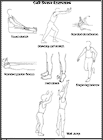
Calf Strain Rehabilitation Exercises
You can begin gently stretching your calf muscle using the towel stretch right away. Make sure you only get a gentle pull and not a sharp pain while you are doing this stretch.
- Towel stretch: Sit on a hard surface with your injured leg stretched out in front of you. Loop a towel around the ball of your foot and pull the towel toward your body keeping your knee straight. Hold this position for 15 to 30 seconds then relax. Repeat 3 times.
After you can do the towel stretch easily, you can start the standing calf stretch.
- Standing calf stretch: Facing a wall, put your hands against the wall at about eye level. Keep the injured leg back, the uninjured leg forward, and the heel of your injured leg on the floor. Turn your injured foot slightly inward (as if you were pigeon-toed) as you slowly lean into the wall until you feel a stretch in the back of your calf. Hold for 15 to 30 seconds. Repeat 3 times. Do this exercise several times each day.
After a couple days of stretching, you can begin strengthening your calf and lower leg muscles using elastic tubing as described in the next 2 exercises.
- Resisted dorsiflexion: Sit with your injured leg out straight and your foot facing a doorway. Tie a loop in one end of the tubing. Put your foot through the loop so that the tubing goes around the arch of your foot. Tie a knot in the other end of the tubing and shut the knot in the door. Move backward until there is tension in the tubing. Keeping your knee straight, pull your foot toward your body, stretching the tubing. Slowly return to the starting position. Do 3 sets of 10.
- Resisted plantar flexion: Sit with your leg outstretched and loop the middle section of the tubing around the ball of your foot. Hold the ends of the tubing in both hands. Gently press the ball of your foot down and point your toes, stretching the tubing. Return to the starting position. Do 3 sets of 10.
You may do the last 3 exercises when you can stand on your toes without pain.
- Heel raises: Balance yourself while standing behind a
chair or counter. Raise your body up onto your toes and
hold it for 5 seconds, then slowly lower yourself down.
Repeat 10 times. Do 3 sets of 10.
You can challenge yourself by standing only on your injured leg and lifting your heel off the ground.
- Single-leg balance: Stand without any support and attempt to balance on your injured leg. Begin with your eyes open and then try to perform the exercise with your eyes closed. Hold the single-leg position for 30 seconds. Repeat 3 times. When you have mastered this, try doing this exercise standing on a pillow.
- Wall jump: Face a wall and place a piece of masking
tape about 2 feet above your head. Jump up with your
arms above your head and try to touch the piece of tape.
Make sure you do a "spring" type of motion and do not
land hard onto your feet. Progress to taking off and
landing on one foot. Do 3 sets of 10.
Another good exercise is hopping. You can start at one end of the room and try to hop as high as you can across the room on one foot. Jumping rope is also a good exercise.

